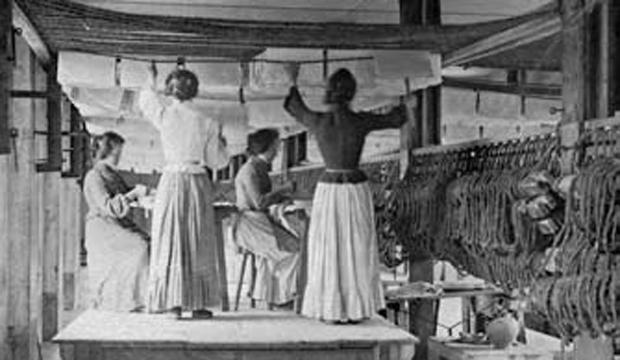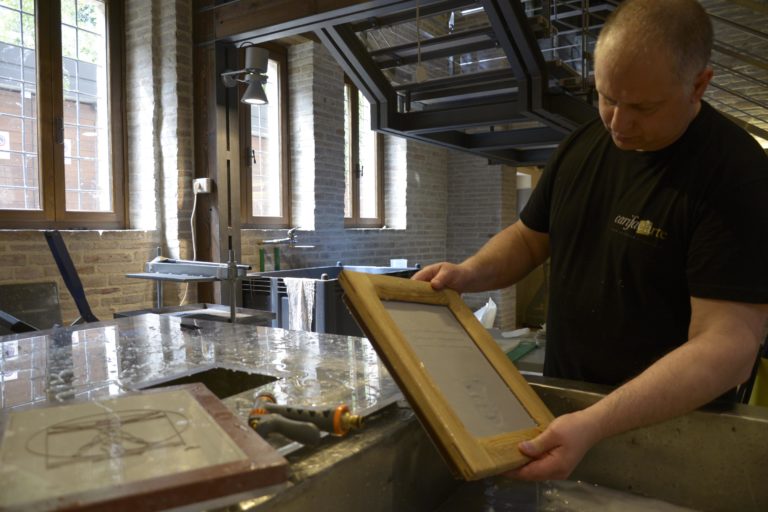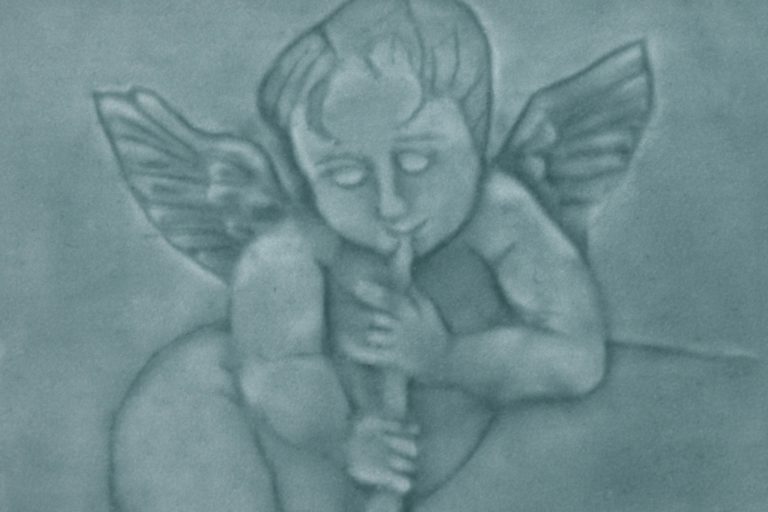STORY
Information documented relative to the 12th, 13th and 14th Centuries, preserved at the “Archivio Storico Comunale di Fabriano” (the Fabriano Council Historical Archives), permits the partial and fragmentary reconstruction of the beginnings and evolution of Fabriano as the centre of papermaking in the Marche region. According to these archives, the paper-makers corporation did not count amongst the twelve artisan corporations that governed the Council and that were listed in the public act of 1278 in Fabriano. Among the twelve the two majors that emerge due to power and dimensions as institutionalised political-economic organizations, ascended to Council power, are those of the merchants and wool producers. The art of wool making preserved in the statutes of 1369 in the historical Fabriano archives reunites, from the 13th Century, artisans and personnel specialized in wool carding, weaving and dyeing with a complete cycle from the raw material to the commercialisation of the finished product. Not only did the wool makers possess an official building but also a building for the “purging” of cloth and a number of rooms equipped for the operation of the (gualcherie or gualchiere) “fulling mill”. The art of wool making may perhaps consider itself the precursor to the initiation of paper-making, a hypothesis confirmed by the papermakers corporation becoming official in 1326 even if only in 1283 the acts of the notary Berretta notes the names of certain Fabriano papermakers. Therefore it may be assumed that these artisans, not yet reunited in an autonomous corporation, operated in the development and experimental phase of a sector promoted and belonging, at the beginning at least, to the same wool craft via common interests and connections. The specification of the “gualchiera a cincis” or more simply the “valchiera” became the more popular term to indicate the small wool mill situated on the Castellano (today known as the Giano) river bank, which was predisposed for processing bamboo paper. The creative talents of the first papermakers favoured a rapid growth of both quality and quantity of paper production and perfected the rudimentary techniques in Fabriano in order to become in a few decades the cradle of paper handicraft in Europe. However the first stepping-stone of this very important development process of the beginning of papermaking in the inland Apennine Marche territory is unfortunately missing in the historical archives. Also because it was favoured by the flourishing manufacture of woollen cloth that with their diverse workmanship phases (some of which like the fulling carried out by the “hammers” operated by water wheels) may have suggested the use of the multiple hammer hydraulic hammer mill to pound the rag cloths, making the sludge for the paper paste, eliminated the stone mortar and the wooden piston operated by hand which was used by the Arabs. To also eliminate the inconvenience of easy deterioration of the sheets due to wheat-starch sizing (being the main reason for avoiding the use of paper for public clerk or notary acts) the Fabriano paper-makers substituted the starch substances with gelatine or animal sizing extracted from the discarded meat of the local tanners. Other important innovations attributed to the Fabriano paper-makers is the perfectioning of the screens used by the workers and paper watermarks that, observed against the light reveal the famous signs initially used to reproduce the trademarks of the diverse paper makers; a necessary distinction already practiced by the wool makers that impressed manufacturing “marks” on their products where the prototypes were deposited in the appropriate corporation registers. The signs (or marks) initially were quite simple and were formed by two letters “I” and “O” from the alphabet, two externally tangent circles, two concentric circles, lines in crosses ended by circles. Within a few years the design was perfected and refined taking on diverse and elegant forms, nurtured by the artisan’s creativity.
HANDMADE PAPER
Fabriano is one of the fewest cities in the world where to this day paper is still manufactured by hand, evidence of the determination of not closing with this past centuries old tradition. The precious sheets that exit from the “tubs” department are utilized for prestigious editions, artistic designs and art prints, correspondence and invitation paper, University degrees, treasury bonds, etc. The raw materials used for this type of production are of the highest selection: cotton, hemp, linen, special colorants; and the very careful preparation of the paste carried out using the old Dutch refining tubs. The central workmanship phase has remained exactly as it was 700 years ago. The “worker” repeats the same movements, as did the Fabrianese paper makers of the 13th Century, immersing, with very delicate hand movements, the wire screen into the tub and extracting the same quantity of paste every time on the whole surface of the wire screen. The cast form is the means by which fibre is felted; the cast form consists of metal wire encased by a “deckle” (wooden frame used in making paper by hand) that is not fixed but rests on the perimeter of the wire screen to permit the bonding of the paste and limit the dimensions of the sheet of paper obtained. Then as soon as the sheet of paper is formed, the worker passes the form to the coucher, after which water is drained off for a moment, rests the form on a woollen felt causing the detachment of the sheet from the wire screen. One sheet and one felt, one on top of the other, forming a stack that is then placed under a hydraulic press: producing the first dehydration of the paper sheets. This particular operation reduces about 50% of water and allows the separation of the sheets from the felt, which can then be arranged on the “hangers”, and hung in large rooms where the air circulation and room temperature complete the drying process. The sizing operation follows the drying process: the dried paper sheets are immersed in an animal sizing tub that renders the paper ink proof and ensures preservation. At this point the paper is ready for the final desiccation again on hangers in the drying rooms. Finally the preparation operations where the paper sheets are “trimmed” via the “selection”, “counting”, “smashing”, “packing”, “glazing” and “curing” in the stock room.
WATERMARK
Watermarks dated back to XV° and XVI° centuryTowards the end of the 1200’s the craftsmen active in Fabriano were in the habit of countersigning their production with watermarks. Today watermarks represent an important testimony to the perfection attained by the Fabriano paper mills in this sector, in particular for the production of value paper. The realization of a watermark with extensive lightface detail begins with the preparation of the punch to transfer the image by ‘projecting’ it on the watermark screen. It is almost certain that the first punches were prepared, in the mid 19th Century, by sculpting the image in “positive” on a surface of a hard wood slab (walnut, cherry and box-wood trees). The punch thus prepared in this manner and then a bronze sheet previously ‘annealed’ is placed on top of the punch and carefully ‘forging’ the two elements with the appropriate forge hammer and felt cushion, the image is then reproduced on the bronze sheet. From the fusion of bronze sculptures in the second half of the 1800’s witnessed the “lost-wax” technique. This particular technique consists in the incision of a wax sheet against light. The engraver removed the wax with the appropriate engraving tools a, creating surfaces or tracks more or less elevated thereby determining the even the finest shades that compose the image. Once the incision process was complete, the wax sheet was then uniformly covered with a subtle layer of refractory earth forming the so called “plastering” process.

Exposed to a temperature of little more than fusion, the wax liquefies and exits from the covering via one or more perforations in the plaster. All this causing a reinforced bronze casting that once cooled constitutes the punch (upper die) to transfer the image to the screen. The same period also witnessed the preparation of the punch for fusion using a chalk “cast” on the incised wax; this process prepares the fusion to obtain the first bronze “punch”. Preparing a second chalk cast and using the same process achieved the “ram-coin dimpling”. In this case though instead of the sheet being forged, the sheet is compressed between the punch and the ram-coin dimpling using an appropriate press the image is then transferred to the screen. The first years of the 20th Century, the technique of preparing the punches used the electrochemical process of galvanoplastic. From the wax original, via a galvanic bath, a negative and a positive copper sheet are produced, which in turn, serve to transfer via pressure the image on a metal screen. At this point the screen is sewn on to other screens which acts as a support and reinforcement and is ready for the final phase which coincides with hand-made paper. The Miliani Paper Mills also produce watermarked paper using a cylinder paper machine and a paper machine. The paper machine uses a “dandy roller” to obtain watermarks, or watermark bodkins for impressed watermarks.










